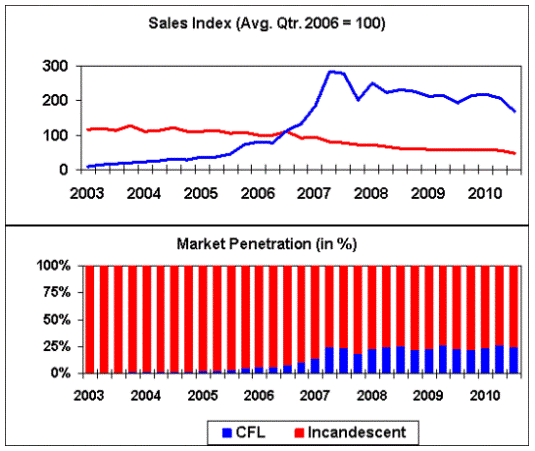|
Incandescent light bulbs are already being phased out in 2011!
The end is not only in sight for the standard incandescent light bulb it's extinction has already started on several levels. First as a lighting distributor, Premier Lighting is seeing less incandescent light bulbs options available from the major manufacturers such as; GE, Westinghouse and Philips. Along with less options available, the price for incandescent light bulbs is increasing because of reduced production and less demand.
This year California will become a test lab for how consumers nationwide may react to new federal lighting efficiency laws taking effect throughout the country on January 1, 2012. Under Title 20, the Golden State's energy commission has the authority to regulate lighting products used by consumers and businesses. As a result of the commission's actions, consumers in California will start to experience the phase out of 100W incandescents starting January 2011, a year before the rest of the country. Californians will also deal with the phasing out of 75W, 60W and 40W incandescents on an accelerated schedule. Which is designed to help educate business and consumers on these changes.
Retail, Ikea announced that its 48 U.S. and Canadian stores will stop selling traditional incandescent light bulbs in 2011, the real story wasn't the bulbs. It was how a shift from the soft white glowing globes of decades past will affect the design of lamps, sconces and chandeliers for decades in the future.
Ikea started phasing out incandescent bulbs August 1, 2010 in the US and Canada markets with the goal of complete elimination by January 1, 2011. The company has also, already stopped selling incandescents in France and Australia as other parts of the world move faster to energy-efficient alternatives.
So, what does the legislation say?
Between 2012 and 2014, standard A-line 40-60-75 and 100-watt incandescent light bulbs must use 30% less energy, but produce the same light output as the incandescent bulbs most of us use today.

What does this mean for you?
While you won't be required to throw out your existing bulbs, you may be surprised when trying to find the same replacements at the store. After 2012, you'll find that these bulbs will have to be replaced with energy-efficient options, such as Halogen, CFL and LED light bulbs.

How much energy can an energy-efficient lighting really save?
The most common alternative to incandescents used today is the CFL. While the upfront investment is more for these bulbs, the cost is more than offset in energy savings, from 50-70% and product longevity, from 4-10 times longer life.
Sales of Incandescent Lamps
As the chart (Top) below indicate there has been a steady decline in the sale incandescent lamps of nearly 19.0 percent each year starting in 2006. While the sales of CFLs has increased at a rate of 4 CFL's to 1 incandescent during the same period and will continue through 2014 when all standard A-line incandescent light bulbs will be phased out.
The second chart (Bottom) shows that since 2007 CFL's have represented a 25% share of the standard 40 watt to 100 light bulb market. The day is approaching when this chart will represent market shares of CFL's, LED and Halogen and incandescent light bulbs will be a notation in history.
Rebates
With that in mind, now is the time to take advantage of the significant rebates available from your utility company for retrofitting incandescent light bulbs to CFL or LED light bulbs. The rebates will most likely decrease or go away when you have no other choice, so contact us today to determine your best lighting option.

|